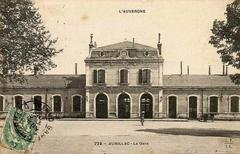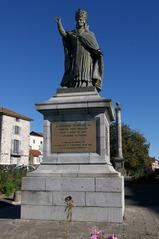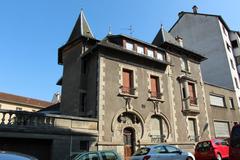Departmental Archives of Cantal, Aurillac, France: Visiting Hours, Tickets, and Historical Sites Guide
Date: 14/06/2025
Introduction
Nestled in the heart of Aurillac, the capital of the Cantal department in France’s Auvergne region, the Departmental Archives of Cantal serve as a crucial gateway to the region’s deep and diverse history. Established following the French Revolution, these archives preserve centuries of heritage, providing a unique lens on everything from medieval manuscripts and parish registers to modern governmental documents and digitized collections. Whether you are a genealogist, historian, or traveler, the Archives offer opportunities to explore the stories that shaped Cantal and Aurillac—from the Arvernes and Roman influence to the modern era (FranceArchives, WikiTree).
Conveniently located at 42 bis rue Paul Doumer, the Archives are easily accessible by public transport and are equipped to accommodate visitors with reduced mobility. Open Monday through Thursday and free to the public, the site not only grants access to a wealth of documents but also offers guided tours, exhibitions, workshops, and an extensive digital platform (archives.cantal.fr, GeneaCantal).
This guide provides essential information on visiting hours, collections, accessibility, and nearby historical sites, as well as practical travel tips to make the most of your time in Aurillac and the Cantal region (Triplyzer). For up-to-date details and self-guided tours, download the Audiala app (Audiala).
Table of Contents
- Introduction
- Historical Background of Cantal and Aurillac
- Visiting the Departmental Archives of Cantal
- Nearby Attractions and Travel Tips
- Frequently Asked Questions (FAQ)
- Conclusion and Call to Action
- References and Further Resources
Historical Background: Cantal and Aurillac
Ancient and Roman Roots
Cantal, historically part of the Auvergne province, was once dominated by the Arvernes—an influential Gallic tribe led by the famed Vercingetorix. Following the Roman conquest, the region became an integral part of “civitas Arvernorum,” with Roman infrastructure and early Christianization leaving a lasting mark (FranceArchives). By the 3rd century, the spiritual power of the Bishop of Clermont was a defining influence.
Medieval and Early Modern Developments
The Middle Ages saw Cantal shaped by feudalism and ecclesiastical power. Local lords, like the viscounts of Carlat, and prominent religious houses, such as the priory of Saint-Flour, played key roles. The mountainous landscape fostered both isolation and the preservation of local customs, with castles, churches, and monasteries built during this era—many of which are referenced in the Archives’ collections.
The 16th and 17th centuries brought religious conflict and administrative flux. The Wars of Religion disrupted the region, and the Counter-Reformation strengthened Catholic institutions (Triplyzer).
The French Revolution and Departmental Creation
The Revolution radically reshaped France’s administrative landscape. In 1790, Cantal was established as a department from Haute-Auvergne and adjacent parishes, named after its volcanic massif (FranceArchives). Aurillac and Saint-Flour initially alternated as departmental capitals, but Aurillac became the permanent prefecture in 1794.
Aurillac’s Transformation
Founded around the 9th-century Abbey of Saint-Géraud, Aurillac grew into a commercial and cultural hub, thanks to its strategic riverside location. The 19th century brought civic expansion, and today Aurillac is recognized for its blend of medieval character, vibrant markets, and festivals (Triplyzer).
Visiting the Departmental Archives of Cantal
Location and Accessibility
- Address: 42 bis rue Paul Doumer, 15000 Aurillac, France
- Contact: +33 (0)4 71 48 33 38
- Public Transport: Easily accessible from the city center, with nearby parking and public transit options.
- Accessibility: Fully wheelchair-accessible; accommodations are available for visitors with disabilities (GeneaCantal).
Visiting Hours and Admission
- Monday to Thursday: 8:30 am–12:00 pm & 1:30 pm–5:00 pm (GeneaCantal)
- Closed: Fridays, weekends, and public holidays
- Admission: Free; on-site registration with valid photo ID required for document access
Collections and Highlights
The Departmental Archives of Cantal safeguard approximately 14 kilometers of documents from the 12th century onward (cantal.gouv.fr). Major holdings include:
- Parish Registers & Civil Registration: Baptisms, marriages, and deaths, vital for genealogical research (archives.cantal.fr).
- Notarial Archives: Contracts, wills, and property records (cantal.fr).
- Census and Military Records: Population and service records spanning centuries.
- Maps & Plans: Historical maps, cadastral surveys, and land registries.
- Photographs & Audiovisual Materials: Historic images, postcards, and local film and sound archives (leguidepratique.com).
- Library Holdings: Newspapers, bulletins, and topographical dictionaries.
- Digital Collections: Over 2 million digitized images, including parish registers and cadastral maps (archives.cantal.fr).
Visitor Facilities and Services
- Reading Room: Open to all registered users; staff provide research guidance.
- Digital Access: Public workstations, free Wi-Fi, and online research tools.
- Exhibitions: Regularly rotating displays, such as the 2025 “De la craie à la plume,” highlighting local history (archives.cantal.fr).
- Educational Programs: Workshops and school visits every Thursday morning.
- Guided Tours: Available by appointment and during special events.
- Accessibility: Elevators, adapted restrooms, and assistance for special needs (Annuaire Mairie).
Digital and Remote Access
Researchers unable to visit in person can access a large selection of digitized documents and research guides online (archives.cantal.fr/vos-archives). Online catalogs, collaborative indexing, and video tutorials support remote research.
Nearby Attractions and Travel Tips
- Saint-Géraud Abbey: The medieval abbey around which Aurillac was founded.
- Château de Saint-Étienne: A historic castle with panoramic views.
- Jardin des Carmes: A tranquil public garden near the Archives.
- Aurillac Museum of Art and Archaeology: Exhibiting regional artifacts.
Travel Tips:
- Best Time to Visit: Late spring to early autumn for mild weather and festivals.
- Getting There: Aurillac is reachable by train, regional flights, and car. Consider car hire for exploring the wider region (choosewhere.com).
- Local Cuisine: Sample Cantal cheese and truffade, regional specialties.
- Accessibility: The Archives and most local attractions are accessible; contact venues in advance for specific needs.
Frequently Asked Questions (FAQ)
Q: What are the Departmental Archives’ opening hours?
A: Monday to Thursday, 8:30 am–12:00 pm & 1:30 pm–5:00 pm; closed Fridays, weekends, and public holidays.
Q: Is admission free?
A: Yes, entry is free; registration required for document consultation.
Q: Can I access records online?
A: Yes, extensive digital collections are available on the official website.
Q: Are guided tours available?
A: Yes, by appointment and during special exhibitions.
Q: Is the building accessible for visitors with disabilities?
A: Yes; elevators, adapted restrooms, and staff assistance are provided.
Conclusion and Call to Action
The Departmental Archives of Cantal are a vital resource for exploring Cantal’s remarkable past, offering free public access, extensive collections, and a range of educational and cultural programs. Whether tracing your ancestry, conducting academic research, or simply exploring Aurillac’s rich heritage, the Archives provide an unparalleled window into the region’s history.
Plan your visit by checking the official website for current opening hours, special events, and digital resources. Download the Audiala app for self-guided tours and up-to-date information on local sites (Audiala). Make the Departmental Archives of Cantal your starting point for discovering the stories and landmarks that define this captivating corner of France.
References and Further Resources
- FranceArchives
- Archives Cantal Official Website
- GeneaCantal Practical Information
- Triplyzer – Things to Do in Aurillac
- Audiala – Aurillac Guide
- cantal.gouv.fr – Les Archives départementales
- Annuaire Mairie – Archives départementales du Cantal
- leguidepratique.com – Aurillac Municipal Archives
- choosewhere.com – Cantal Visitor Guide



